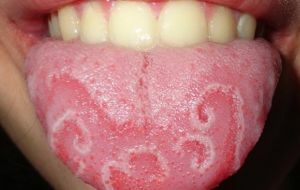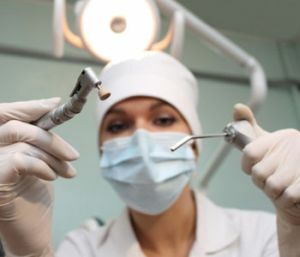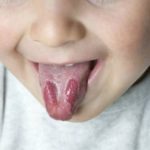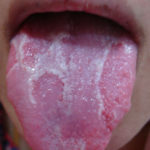 Among the diseases affecting the oral mucosa are separately desquamative glossitis or, as it is also called, geographical language. This pathology is formed on the shell of the tongue and transforms its appearance. How exactly and why is this happening?
Among the diseases affecting the oral mucosa are separately desquamative glossitis or, as it is also called, geographical language. This pathology is formed on the shell of the tongue and transforms its appearance. How exactly and why is this happening?
On the surface of the tongue there appear areas of desquamation of the epithelium, that is, areas on which peeling and sloughing occurs. And these areas can vary in size, shape and location. Currently, the disease is quite common. Specifically scaly peeling is called desquamation.
Outlines of foci of pathology may resemble a geographical map. The appearance and disappearance of foci occurs very quickly. Most often they migrate from one part of the language to another. The disease is more common in schoolchildren and preschoolers, and it is also likely that more adults, mostly women, will be affected.
Contents
- What is the reason for the development of pathology?
- Nature of the clinical picture
- Diagnostic methods
- Medical assistance
- Preventive measures
What is the reason for the development of pathology?
It was not possible to establish the causes of this disease unequivocally, but at the current stage of medicine specialists formed a certain point of view: geographical language is associated with trophic disturbance.
Pathology can be both independent and developing in parallel with another disease. Hence, there is a division into forms: the primary and secondary desquamative glossitis.
Primary form can result from a trauma of the tongue that occurs due to contact with the edges of the incisors. Also, the disease can develop due to chemical or thermal burns, or be caused by improperly installed dentures. In a small child, the geographical language develops during the period of teething.
As for the secondary form, it develops due to pathological processes. This is due to the increased sensitivity of the mucous tongue to any functional changes. Quite often desquamation of the epithelium in the language accompanies chronic pathologies, for example, diseases affecting the gallbladder, liver, vitamin-mineral metabolism, vegetative disorders and others.
The disease can develop as a result of influenza, typhoid fever, scarlet fever and others.
Photo gallery of children diagnosed with geographical language:
There are also cases of hereditary desquamative glossitis.
The nature of the clinical picture of
The desquamative glossitis can be suspected by external signs and characteristic symptoms:
- on the of the initial stage , a whitish gray opacification of the epithelium is observed in the tongue, the diameter of the formation being no more than 2-3 mm;
- on the of the later stage of the formation of bulging, in the central part there are peculiar pinched papillae, under which there is a red or bright pink region with a rounded shape( on the general background of the tongue, the formation is very strongly prominent), the deformed portion is prone to accelerated growth, This evenness of the edges is preserved, although the intensity of the disease decreases.
When the focus increases to its maximum size, its boundaries begin to blur, while in the center there is a restoration of the  normal state of the mucosa. At the same time, in those areas where keratinization occurs, desquamation occurs at this moment.
normal state of the mucosa. At the same time, in those areas where keratinization occurs, desquamation occurs at this moment.
The disease is characterized by both multiple and single pockets of desquamation. Often observed is the first option. With that account, that they constantly change, layering desquamation occurs.
Thus, in those places where there were old foci, new ones are formed, and the surface of the language acquires the form of a geographical map. Actually such process also became the reason of formation of the name of a pathology - a geographical language or migrating glossitis. The overall picture can change even every day. What is most remarkable is that this defeat can affect any area of the language, except the bottom.
The majority of patients learn about the presence of a problem only after examination, because pathology has no subjective sensations. In some cases, there are patients who have a feeling of tingling, burning, pain while eating and paresthesia. In addition, the cause for concern is the appearance of the surface of the tongue. As a result of the disease, carcinophobia may develop.
The course of the disease is strongly influenced by stressful and emotion-filled situations. As a consequence, the pathology is more severe. Desquamative glossitis can become aggravated from time to time, it is often associated with exacerbation of somatic pathologies. In 50% of all cases, the disease occurs in parallel with the folded tongue.
The duration of the course of the disease is uncertain, but it is a long process. With all this, pathology can not disturb at all.
The geographic language is characterized by a temporary disappearance, and this period can be quite long, but after some time in the same places, the re-identification of characteristic features begins.
For the reasons that provoke the geographical language of the child, as well as the symptoms and treatment of the disease, Dr. Komarovsky will tell:
Diagnostic methods
In order to diagnose the disease, specialists resort to a whole range of methods:
- is going to anamnesis, in addition, a patient is questioned during whichcomplaints that cause discomfort are identified;

- the patient's mouth is examined;
- is obligatory to collect bacteriological sowing from the affected area, thus, specialists identify the causative agent that caused the disease;
- also specialists produce a polymerase chain reaction, that is, DNA reveals the nature of the causative agent of the disease;
- is an enzyme-linked immunosorbent assay that targets the detection of specific antibodies in body fluids;
- scraping with a microscope is studied in detail on treponemia, an anticardiolipin test is performed, and the immunofluorescence reaction is tested to differentiate the lesion of the tongue with suspected syphilis;
- in the diagnosis of the disease requires the collection of feces to identify the eggs of the worm, in order to exclude the probability of a parasitic nature of the pathology.
Because the geographic language is often differentiated from a number of diseases, the specialist compares the symptoms, while paying special attention to the nature of the foci and their movement. In addition, the results are evaluated from the laboratory.
Medical assistance
In order to get rid of the disease, first of all, the sanation of the oral cavity is necessary. The procedure is a professional hygiene. The specialist removes hard and soft dental deposits, eliminates caries and replaces substandard prostheses and seals.
 No less important is proper nutrition. The doctor appoints a special diet, which implies the exclusion from the diet of alcoholic beverages and food, serving as an irritant.
No less important is proper nutrition. The doctor appoints a special diet, which implies the exclusion from the diet of alcoholic beverages and food, serving as an irritant.
In the case when the geographical language is combined with folded, doctors pay attention to the severity of the pathology. The collected food remains, plaque and other contaminants are an excellent condition for the formation of microorganisms responsible for the development of the disease.
In the case when the patient does not experience discomfort, there is no need for special treatment. In some cases, there may be a sensation of tingling and burning( this occurs during chewing food), in such cases, the patient is prescribed rinsing the mouth with antiseptics and epithelial preparations.
If the disease is accompanied by a severe pain syndrome, then local anesthetics are needed. In some cases, novocain blockades are used, which are located at the site of passage of the lingual nerve.
In addition to measures aimed at eliminating the geographical language, an important role is played by the identification and proper treatment of concurrent systemic pathologies. First of all, the gastrointestinal tract, the nervous and endocrine system is examined.
In addition to the above activities, it may be necessary to consult a medical psychologist or psychotherapist. Also beneficial are herbal medicines and collections, a complex of microelements and vitamins, antihistamines and biostimulating effects. In addition, vascular drugs and local analgesic are recommended.
As a result of desquamative glossitis, serious carcinophobia can develop in elderly people, that is, the fear of overgrowing the disease into cancer or other complex diseases. But in fact, as a benign disease, the geographical language does not become malignant.
Preventive measures
With regard to preventive measures, the following rules will be required:
- enrichment of the body with vitamins by consuming foods rich in useful microorganisms and taking medications in tablet form( patients need B vitamins);
- rejection of addictions, complete exclusion from the diet of alcoholic beverages, it is necessary to reduce the amount of coffee and sugar consumed and it is recommended to give up the habit of smoking;
- it is necessary to carry out an in-time examination by specialists and, if necessary, to treat all the diagnosed diseases;
- mandatory condition is the observance of oral hygiene and timely treatment of incisors and diagnosed diseases of the oral cavity.



